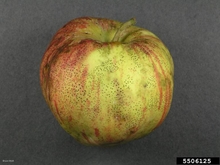Quick facts
- Sooty blotch and flyspeck usually appear in August or September and are sometimes called the "summer diseases” of apples.
- Sooty blotch causes dark smudges on the surface of the apple.
- Flyspeck causes clusters of small black dots
- Both fungi are limited to the surface of the fruit and do not cause rot.
- Manage these diseases by maintaining good air circulation within the tree.
- Fruit with sooty mold or flyspeck are edible.
How to identify sooty blotch and flyspeck
Sooty blotch
- Smudges on the apple’s surface that are gray, green, brown or black.
- Smudges can be rubbed or washed off the fruit fairly easily.
Flyspeck
- Clusters of tiny black dots on the apple’s surface.
- Dots can’t be easily cleaned off the fruit.
How do these diseases survive and spread?
- Flyspeck and sooty blotch are caused by a complex of several different fungi.
- These fungi don’t cause fruit rot because they don’t infect the live cells of the fruit.
- They only grow in the waxy cuticle on the fruit surface, resulting in minor blemishes.
- The fungi overwinter on the fruit, stems, leaves and bark of many types of woody plants, including apples, pears and raspberries.
- Warm, humid weather encourages spore development and germination.
- Rain and wind spread the spores onto developing fruit.
- These diseases are more common in the southern half of Minnesota.
How to manage these diseases
In a home garden, no action is needed to control these diseases because they don’t affect fruit quality and sooty blotch can easily be cleaned off the apples.
Maintain good air circulation
Minimize infections by providing good air circulation in the tree. This allows the fruit to dry quickly after rain and prevents disease spores from germinating.
- Prune your trees to allow good air circulation in the tree canopy.
- Thin fruit to only one per cluster to allow good air circulation around each individual fruit.
Reviewed in 2024



